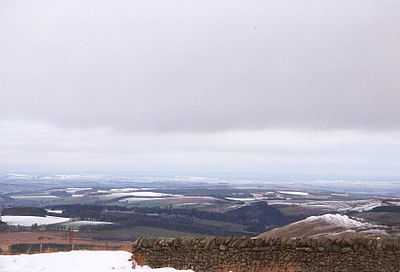Carter Bar
Coordinates: 55°21′14″N 2°28′41″W / 55.354°N 2.478°W
| Carter Bar | |
|---|---|
 Carter Bar | |
| OS grid reference | NT697068 |
| |
The Carter Bar is the point at which the A68 crosses the England–Scotland border and forms a pass located at the top of Redesdale in the Cheviot Hills at an elevation of 418 metres (1,371 ft). The first sizeable Scottish town is Jedburgh approximately 12 miles (19 km) north. Other nearby Scottish towns include Hawick 16 miles (26 km) away and Kelso, 22 miles (35 km) away. On the English side, the first settlement is Byrness, followed by Redesdale, with Otterburn next at the junction of the A68 and A696 then Newcastle upon Tyne 45 miles (72 km) away. The A696 and A68 combine to form one of the main routes (and a popular scenic tourist route) between Newcastle upon Tyne and the Scottish capital, Edinburgh.
In 1575 Carter Bar was the scene of the Raid of the Redeswire, one of the last large-scale battles between the English and the Scots.
Carter Bar was the location of Truce days, that were held between the Lord Wardens of the Marches of both countries to dispense cross border justice in the Late Middle Ages and Early modern period. Truce days were also held at Carlisle and Berwick upon Tweed.
Carter Bar forms a popular point for tourists to stop and take photographs on the Anglo-Scottish border. There are two marker stones on either side of the A68 for this purpose, the original stone created by local Borders stonemason, Edy Laub. Upper Redesdale, the Scottish Borders (including Tweeddale) and to the east, the Cheviot hills are all visible from Carter Bar. However, its altitude means snow is possible even in late spring and early autumn, and the Carter Bar pass can be subject to frequent snow-related closures during the winter.
